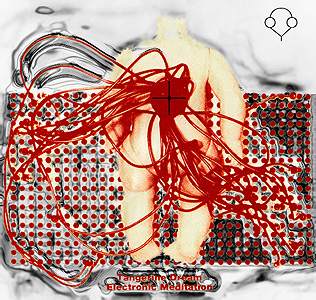D>Elektro 1.2 - |> expanded concept <|
|>NEWland
But those experiments and de(con)structions were serving more than just a symbolic destruction of the overall order. Out of those self-produced or discovered sound-structures, groups like Faust and CAN were shaping, quite unconcerned by the usual misunderstandings or even hostilities, their very own new sound-elements.
| "CAN are
a very particular group - the perfect link between pop
and avantgarde - the most influential musical force coming from
the european continent and the best example of a band that's ahead
of our time. They are more origninal, than it seems at all possible."
David Elliot [SOUNDS Magazine]
|
Besides the pioneering work of generating new, unheard sounds by using new or manipulated electronic gadgets - which has been mostly done by Tangerine Dream and Klaus Schulze, this particular sound-montage-work - live and in the studio - counts among the greatest steps, that those German musicians set into the musical NEWland.
| "FAUST
oscillated wildly between filthy, fucked-up noise and gorgeous pastoral
melody, between yowling antics and exquisitely-sculpted sonic objets
d'art. Above all, Faust were maestros of incongruity; their albums
are riddled with jarring juxtapositions and startling
jumpcuts between styles. Heterogeneity was their anti-essence.
Krautrock was true fusion, merging psychedelic rock with funk groove, jazz improvisation, Stockhausen-style avant-electronics and ethnic flava. The 'Krauts' anticipated the soundpainting and texturology of today's post-rock, while still retaining the rhythmic thrust of rock'n'roll."
Simon Reynolds - 'Krautrock' - Melody Maker - 7/96
|
When Rolf-Ulrich Kaiser, the head of Ohr Records [Ear Rec.], heard Electronic Meditation (the 1st Tangerine Dream LP) , he said:
"Okay, there's no market for this, but we sign you."
And this initial spark soon set fire to an international acclaim - Tangerine Dream, with their later move to the British VIRGIN Label, set in motion their worldwide success.

| "The
results were wild
- to put it mildly. Electronic Meditation is archaic, modern and futuristic at the same time. Though it was recorded with electronic and acoustic instruments, it is so unorthodox, that, technologically, it sounds so direct and effortless, as if a caveman who makes music with his bare hands and feet."
Julian Cope ueber 'E.M.' von Tangerine Dream [1969]
|
| D>Elektro |1.2.1| |>NEWland |
| |> The Debris | The Void + The New Elements <| |
| <| ...Newland... |> | |
| <| Rwd: | Electrochildren + The Sound of the Debris | |
| ||> Fwd: |1.2.2 | Sounds + Elements | |